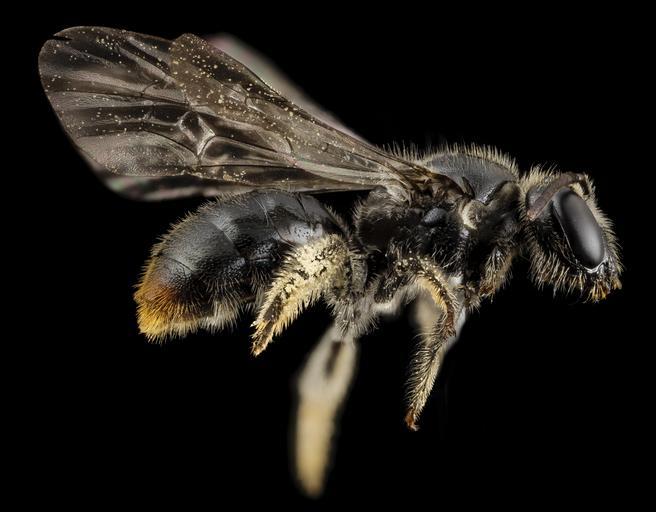MAKE A MEME
View Large Image

| View Original: | bee_small_red_tip,_f,_chile,_side_2014-08-08-17.43.13_ZS_PMax.jpg (4183x3266) | |||
| Download: | Original | Medium | Small | Thumb |
| Courtesy of: | www.flickr.com | More Like This | ||
| Keywords: bee bees chile apidae taxonomy:binomial=manuelia postica taxonomy:binomial=manueliapostica manuelia postica manueliapostica manuelia red red tip redtip biml usgs usgsbiml droege zerene stacker zerenestacker stackshot twig-nester twignester south america southamerica black background animal macro insect Manuelia postica, Red-tipped Twignester, collected in Chile Red-tipped Twignesters live and nest, as the name implies, in the pith or hollow centers of dead plant stems. A set of nest cells are made sequentially along the length of the stem from back to front. One home security problem that these and other similar bees have is that while the female is out foraging for pollen and nectar another bee or nest parasite of some kind can invade and usurp the nest, steal the pollen, or lay their eggs in the nest. To decrease the possibility of this happening the female, when present in the nest, guards the entrance and when any possible invader arrives she presents her sting end at the opening. To presumably increase the chances that a nest will be successful sometimes two females will occupy the same nest, allowing one to act as guard while the other forages. Experiments have shown that these bees can recognize their nestmates. The chemical signature embedded in their cuticles houses the signal for that recognition. The Red-tipped Twignester is one of only three species in the genus, all restricted to southern South America. They are easy to differentiate by color alone – one is blue, one is smaller and all black, and this one – you can tell what color it is from the picture. ~~~~~~~~~~{{{{{{0}}}}}}~~~~~~~~~~ All photographs are public domain, feel free to download and use as you wish. Photography Information: Canon Mark II 5D, Zerene Stacker, Stackshot Sled, 65mm Canon MP-E 1-5X macro lens, Twin Macro Flash in Styrofoam Cooler, F5.0, ISO 100, Shutter Speed 200 Further in Summer than the Birds Pathetic from the Grass A minor Nation celebrates Its unobtrusive Mass. No Ordinance be seen So gradual the Grace A pensive Custom it becomes Enlarging Loneliness. Antiquest felt at Noon When August burning low Arise this spectral Canticle Repose to typify Remit as yet no Grace No Furrow on the Glow Yet a Druidic Difference Enhances Nature now -- Emily Dickinson Want some Useful Links to the Techniques We Use? Well now here you go Citizen: Basic USGSBIML set up: www.youtube.com/watch?v=S-_yvIsucOY USGSBIML Photoshopping Technique: Note that we now have added using the burn tool at 50% opacity set to shadows to clean up the halos that bleed into the black background from "hot" color sections of the picture. www.youtube.com/watch?v=Bdmx_8zqvN4 PDF of Basic USGSBIML Photography Set Up: ftp://ftpext.usgs.gov/pub/er/md/laurel/Droege/How%20to%20Take%20MacroPhotographs%20of%20Insects%20BIML%20Lab2.pdf Google Hangout Demonstration of Techniques: plus.google.com/events/c5569losvskrv2nu606ltof8odo or www.youtube.com/watch?v=4c15neFttoU Excellent Technical Form on Stacking: www.photomacrography.net/ Contact information: Sam Droege [email protected] 301 497 5840 Manuelia postica, Red-tipped Twignester, collected in Chile Red-tipped Twignesters live and nest, as the name implies, in the pith or hollow centers of dead plant stems. A set of nest cells are made sequentially along the length of the stem from back to front. One home security problem that these and other similar bees have is that while the female is out foraging for pollen and nectar another bee or nest parasite of some kind can invade and usurp the nest, steal the pollen, or lay their eggs in the nest. To decrease the possibility of this happening the female, when present in the nest, guards the entrance and when any possible invader arrives she presents her sting end at the opening. To presumably increase the chances that a nest will be successful sometimes two females will occupy the same nest, allowing one to act as guard while the other forages. Experiments have shown that these bees can recognize their nestmates. The chemical signature embedded in their cuticles houses the signal for that recognition. The Red-tipped Twignester is one of only three species in the genus, all restricted to southern South America. They are easy to differentiate by color alone – one is blue, one is smaller and all black, and this one – you can tell what color it is from the picture. ~~~~~~~~~~{{{{{{0}}}}}}~~~~~~~~~~ All photographs are public domain, feel free to download and use as you wish. Photography Information: Canon Mark II 5D, Zerene Stacker, Stackshot Sled, 65mm Canon MP-E 1-5X macro lens, Twin Macro Flash in Styrofoam Cooler, F5.0, ISO 100, Shutter Speed 200 Further in Summer than the Birds Pathetic from the Grass A minor Nation celebrates Its unobtrusive Mass. No Ordinance be seen So gradual the Grace A pensive Custom it becomes Enlarging Loneliness. Antiquest felt at Noon When August burning low Arise this spectral Canticle Repose to typify Remit as yet no Grace No Furrow on the Glow Yet a Druidic Difference Enhances Nature now -- Emily Dickinson Want some Useful Links to the Techniques We Use? Well now here you go Citizen: Basic USGSBIML set up: www.youtube.com/watch?v=S-_yvIsucOY USGSBIML Photoshopping Technique: Note that we now have added using the burn tool at 50% opacity set to shadows to clean up the halos that bleed into the black background from "hot" color sections of the picture. www.youtube.com/watch?v=Bdmx_8zqvN4 PDF of Basic USGSBIML Photography Set Up: ftp://ftpext.usgs.gov/pub/er/md/laurel/Droege/How%20to%20Take%20MacroPhotographs%20of%20Insects%20BIML%20Lab2.pdf Google Hangout Demonstration of Techniques: plus.google.com/events/c5569losvskrv2nu606ltof8odo or www.youtube.com/watch?v=4c15neFttoU Excellent Technical Form on Stacking: www.photomacrography.net/ Contact information: Sam Droege [email protected] 301 497 5840 | ||||